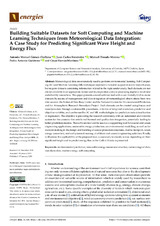Mostrar el registro sencillo del ítem
Building Suitable Datasets for Soft Computing and Machine Learning Techniques from Meteorological Data Integration: A Case Study for Predicting Significant Wave Height and Energy Flux
| dc.contributor.author | Gómez-Orellana, Antonio Manuel | |
| dc.contributor.author | Fernández, Juan Carlos | |
| dc.contributor.author | Dorado Moreno, Manuel | |
| dc.contributor.author | Gutiérrez, Pedro A. | |
| dc.contributor.author | Hervás-Martínez, César | |
| dc.date.accessioned | 2021-01-18T10:34:28Z | |
| dc.date.available | 2021-01-18T10:34:28Z | |
| dc.date.issued | 2021 | |
| dc.identifier.uri | http://hdl.handle.net/10396/20980 | |
| dc.description.abstract | Meteorological data are extensively used to perform environmental learning. Soft Computing (SC) and Machine Learning (ML) techniques represent a valuable support in many research areas, but require datasets containing information related to the topic under study. Such datasets are not always available in an appropriate format and its preparation and pre-processing implies a lot of time and effort by researchers. This paper presents a novel software tool with a user-friendly GUI to create datasets by means of management and data integration of meteorological observations from two data sources: the National Data Buoy Center and the National Centers for Environmental Prediction and for Atmospheric Research Reanalysis Project. Such datasets can be created using buoys and reanalysis data through customisable procedures, in terms of temporal resolution, predictive and objective variables, and can be used by SC and ML methodologies for prediction tasks (classification or regression). The objective is providing the research community with an automated and versatile system for the casuistry that entails well-formed and quality data integration, potentially leading to better prediction models. The software tool can be used as a supporting tool for coastal and ocean engineering applications, sustainable energy production, or environmental modelling; as well as for decision-making in the design and building of coastal protection structures, marine transport, ocean energy converters, and well-planned running of offshore and coastal engineering activities. Finally, to illustrate the applicability of the proposed tool, a case study to classify waves depending on their significant height and to predict energy flux in the Gulf of Alaska is presented. | es_ES |
| dc.format.mimetype | application/pdf | es_ES |
| dc.language.iso | eng | es_ES |
| dc.publisher | MDPI | es_ES |
| dc.rights | https://creativecommons.org/licenses/by/4.0/ | es_ES |
| dc.source | Energies 14(2), 468 (2021) | es_ES |
| dc.subject | Environmental prediction | es_ES |
| dc.subject | Renewable energy resource evaluation | es_ES |
| dc.subject | Meteorological data | es_ES |
| dc.subject | Reanalysis data | es_ES |
| dc.subject | Marine energy | es_ES |
| dc.subject | Soft computing | es_ES |
| dc.title | Building Suitable Datasets for Soft Computing and Machine Learning Techniques from Meteorological Data Integration: A Case Study for Predicting Significant Wave Height and Energy Flux | es_ES |
| dc.type | info:eu-repo/semantics/article | es_ES |
| dc.relation.publisherversion | http://dx.doi.org/10.3390/en14020468 | es_ES |
| dc.relation.projectID | Gobierno de España. TIN2017-85887-C2-1-P | es_ES |
| dc.relation.projectID | Junta de Andalucía. UCO-1261651 | es_ES |
| dc.rights.accessRights | info:eu-repo/semantics/openAccess | es_ES |

